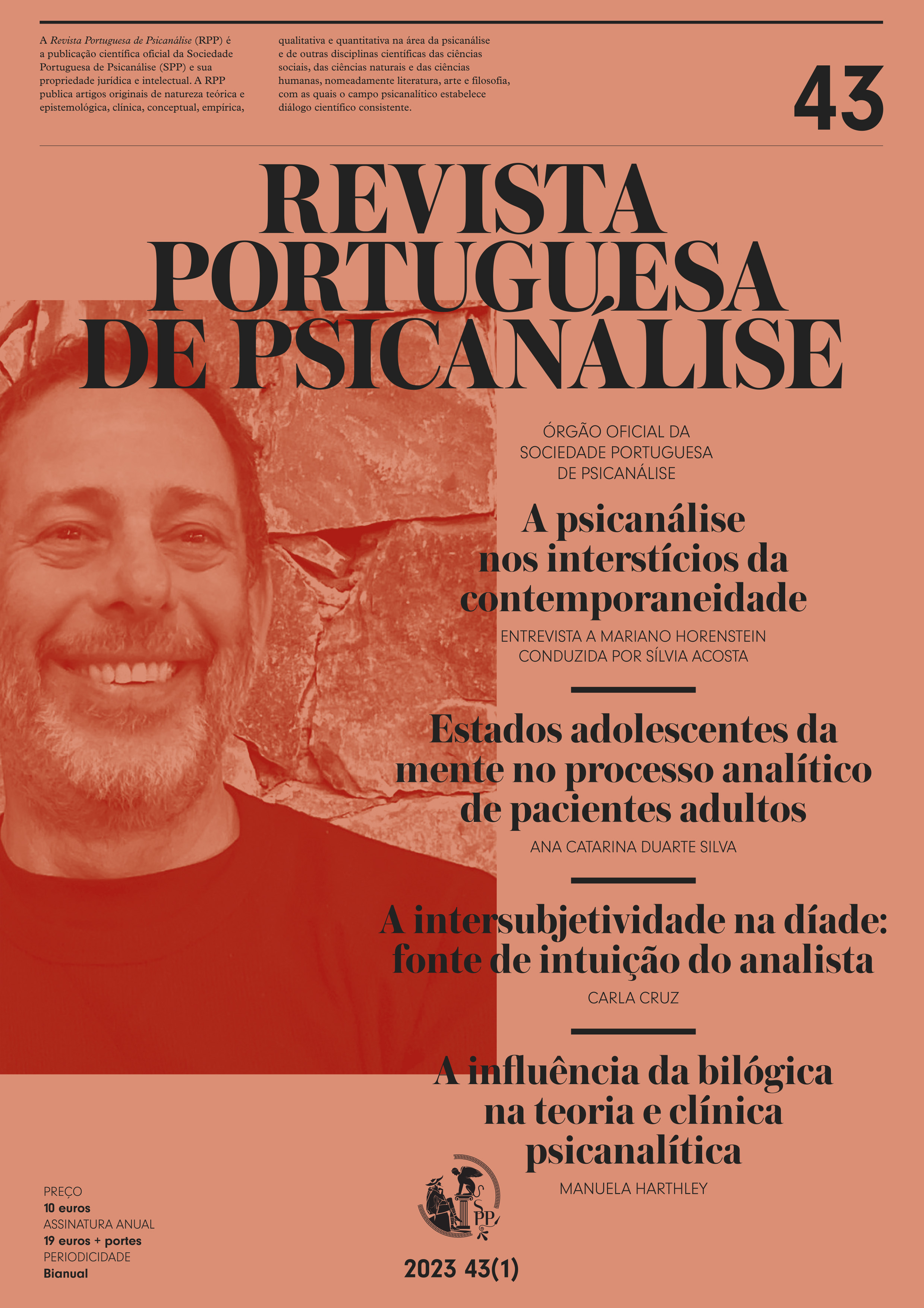Do amor (e do ódio) na contratransferência às violações dos limites sexuais na relação analítica

Resumen
O amor (como o ódio) contratransferencial é omnipresente na relação analítica, ainda que sob diferentes formas, e não apenas transmite informações cruciais sobre o paciente e sobre o próprio analista como é mesmo imprescindível para a criatividade do processo analítico. Mas seja qual for a forma de amor em causa, ela deve ser distinguida, sempre, da violação dos limites da relação analítica que constituirá qualquer contacto sexual entre analista e analisando, transgressões que estão presentes na prática psicanalítica desde os seus primórdios. Importa, por isso, esclarecer o que entendemos por amor contratransferencial e identificar as suas funções no processo psicanalítico, atentando não só ao seu papel terapêutico, mas também ao seu papel destrutivo. Assim, a partir de uma revisão bibliográfica sobre o tema e da inclusão de duas breves vinhetas clínicas, propomos uma reflexão em torno do amor contratransferencial e, posteriormente, de algumas das especificidades da teoria e da prática psicanalíticas — bem como do funcionamento institucional — que podem, de algum modo, contribuir para a manutenção das transgressões sexuais dos limites da relação terapêutica, finalizando com algumas propostas de debate sobre estratégias que visem a prevenção da ocorrência desse tipo de violações.
Biografía del autor/a
Orlando von Doellinger
Psicanalista, Médico Psiquiatra, Doutorado em Psicologia Clínica. Membro com funções didáticas da Sociedade Portuguesa de Psicanálise (SPP).
Citas
- Blechner, M. J. (2014). Dissociation among Psychoanalysts about Sexual Boundary Violations. Contemporary Psychoanalysis, 5(1–2), 23–33. https://doi.org/10.1080/00107530.2014.868299
- Celenza, A. (2021). Shadows that corrupt: Present absences in the psychoanalytic process. Em
- C. Levin (Ed.), Sexual boundary trouble in psychoanalysis – Clinical perspectives on Muriel Dimen’s concept of the “Primal Crime” (pp. 77–93). Routledge.
- Dimen, M. (2011). Lapsus Linguae, or a Slip of the Tongue?: A Sexual Violation in an Analytic Treatment and its Personal and Theoretical Aftermath. Contemporary Psychoanalysis, 47(1), 35–79. https://doi.org/10.1080/00107530.2011.10746441
- Dimen, M. (2016). Rotten Apples and Ambivalence: Sexual Boundary Violations through a Psychocultural Lens. Journal of the American Psychoanalytic Association, 64(2), 361–373. https://doi. org/10.1177/0003065116640816
- Elise, D. (2019). Creativity and the erotic dimensions of the analytic field. Routledge.
- Ferenczi, S. (1980). Final Contributions to the Problems and Methods of Psycho-Analysis. Maresfield Reprints. (Original publicado em 1933.)
- Freud, S. (1966). Observac?o?es sobre o amor transferencial (Novas recomendac?o?es sobre a te?cnica de psicana?lise III). Edic?a?o Standard Brasileira das Obras Completas de Sigmund Freud (vol. xii, pp. 177–188). Imago. (Original publicado em 1915.)
- Frosch, J. P. (2021). The analyst’s narcissism and the denial of limits. Em C. Levin (Ed.), Sexual boundary trouble in psychoanalysis – Clinical perspectives on Muriel Dimen’s concept of the “Primal Crime” (pp. 105–116). Routledge.
- Gabbard, G. O. (1991). Psychodynamics of Aexual Boundary Violations. Psychiatric Annals, 21(11), 651–655. https://doi.org/10.3928/0048-5713- 19911101-06
- Gabbard, G. O. (1994). Sexual Excitement and Countertransference Love in the Analyst. Journal of the American Psychoanalytic Association, 42(4), 1083–1106. https://doi.org/10.1177/000306519404200408
- Gabbard, G. O. (1996). Lessons to be Learned from the Study of Sexual Boundary Violations. American Journal of Psychotherapy, 50(3), 311–322. https://doi. org/10.3109/00048679709073839
- Gabbard, G. O. (1999). Boundary Violations and the Psychoanalytic Training System. Journal of Applied Psychoanalytic Studies, 1, 207–221. https://doi.org/10.1023/A:1023200230822
- Gabbard, G. O. (2002). Post-termination sexual boundary violations. Psychiatric Clinics of North America, 25, A593–A603. http://dx.doi. org/10.1016/S0193-953X(02)00006-0
- Gabbard, G. O. (2017). Sexual boundary violations in psychoanalysis: A 30-year retrospective. Psychoanalytic Psychology, 34(2), 151–156. http:// dx.doi.org/10.1037/pap0000079
- Gabbard, G. O., & Lester, E. P. (1995). Boundaries and boundary violations in psychoanalysis. Basic Books.
- Guralnik, O. (2021). Sex and ethics: protecting an enchanted space. Em C. Levin (Ed.), Sexual boundary trouble in psychoanalysis – Clinical perspectives on Muriel Dimen’s concept of the “Primal Crime” (pp. 94–104). Routledge.
- Levin, C. (2021). Introduction – From “Eew” to we: an overview of Muriel Dimen ?s contribution to psychoanalytic ethics. Em C. Levin (Ed.), Sexual boundary trouble in psychoanalysis – Clinical perspectives on Muriel Dimen’s concept of the “Primal Crime” (pp. 1–21). Routledge.
- Levine, H. B. (2010). Sexual boundary violations: A psychoanalytic approach. British Journal of Psychotherapy, 26(1), 50–63. https://doi.org/10.1111/j.1752-0118.2009.01155.x
- Nacht, S. (1962).The curative factors in psychoanalysis. International Journal of Psychoanalysis, 43, 206–211.
- Pinsky, E. (2011). The Olympian Delusion. Journal of the American Psychoanalytic Association, 59(2), 351–376. https://doi. org/10.1177/0003065111406274
- Rabin, H. M. 2003. Love in the Coutertransference – Controversies and Questions. Psychoanalytic Psychology, 20(4), 677–690. https://doi. org/10.1037/0736-9735.20.4.677
- Saketopoulou, A. (2020). The Infantile Erotic Countertransference:The Analyst’s Infantile Sexual, Ethics, and the Role of the Psychoanalytic Collective. Psychoanalytic Inquiry, 40(8), 659–677. https://doi.org/10.1080/073516 90.2020.1826280
- Saketopoulou, A. (2017). Muriel Dimen: Teacher, Mentor, Psychoanalytic Scholar. Studies in Gender and Sexuality, 18(2), 143–48. http:// dx.doi.org/10.1080/15240657.2017.1312885
- Sherby, L. B. (2009). Considerations on Countertransference Love. Contemporary Psychoanalysis, 45(1), 65–81. https://doi.org/10.1 080/00107530.2009.10745987
- Slochower, J. (2017). Don’t tell anyone. Psychoanalytic Psychology, 34(2), 195–200. https://doi.org/10.1037/pap0000082
- Tubert-Oklander, J. (2021). Do we really need boundaries?. Em C. Levin (Ed.), Sexual boundary trouble in psychoanalysis – Clinical perspectives on Muriel Dimen’s concept of the “Primal Crime” (pp. 171–186). Routledge.
- Wrye, H. K., & Welles, J. K. (1994). The narration of desire: Erotic transferences and countertransferences. The Analytic Press.